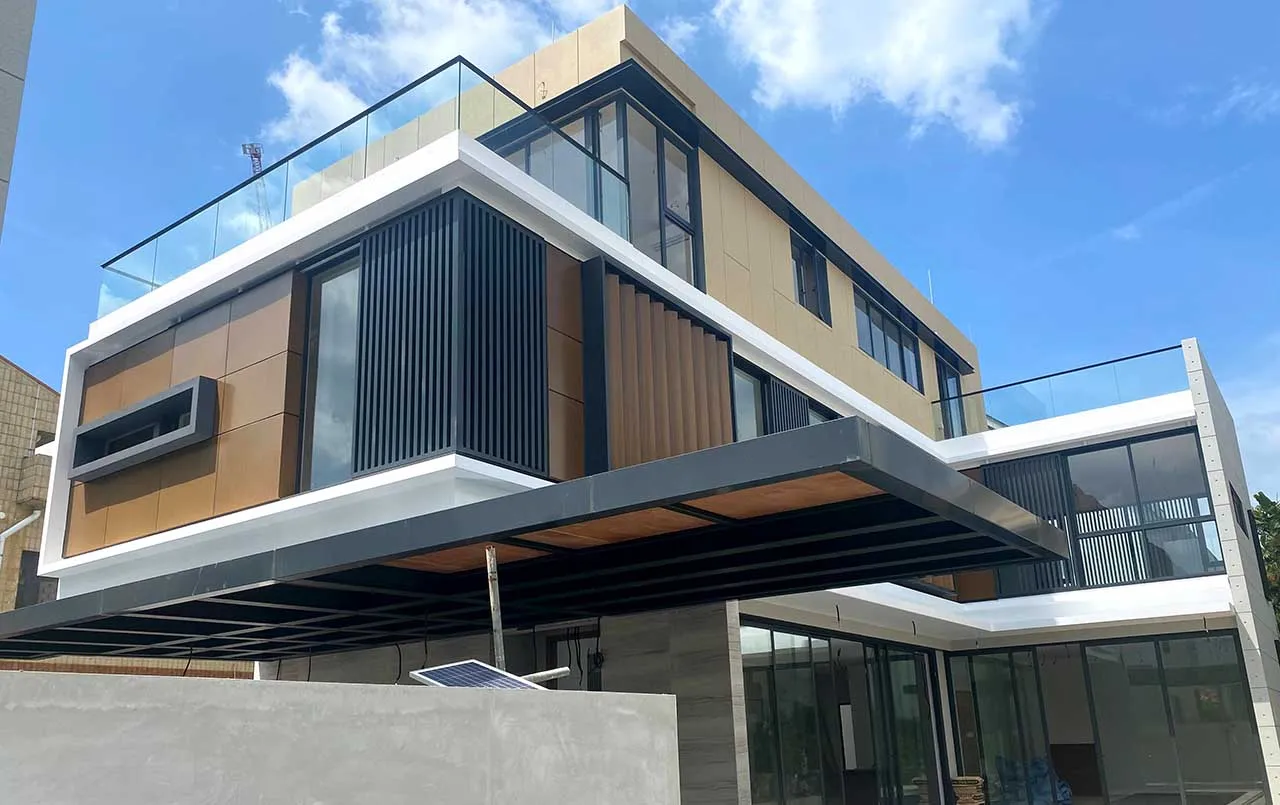Tired of renting and dreaming of owning your own home? As a civil servant, building a house in Nigeria presents unique challenges but don’t worry – it’s far from impossible! This comprehensive guide will walk you through creating the perfect 4-bedroom bungalow that caters to your budget and lifestyle. We’ll cover everything from understanding the Nigerian housing market to choosing eco-friendly materials and incorporating smart home technology. Get ready to turn your dream home into a reality!
How to Create a Functional, Comfortable, and Cost-Effective Bedroom Bungalow Residence for a Civil Servant
We understand that being a civil servant in Nigeria doesn’t always come with a hefty paycheck. But, that shouldn’t stop you from owning a comfortable and stylish home! Imagine a single-level bungalow – a practical and budget-friendly canvas awaiting your personal touch. Let’s explore how to transform this vision into a reality:
1. Make the Most of Your Space
- Embrace Open Floor Plans: Create an airy, spacious feel by allowing your living room to flow seamlessly into your dining area. Open floor plans eliminate cramped hallways and maximize the perception of space.
- Choose Multi-Functional Furniture: Opt for furniture that serves double duty, like ottomans with hidden storage or coffee tables that convert into dining tables. This maximizes space and minimizes clutter.
- Utilize Wall Space: Transform unused wall space into storage havens! Install sleek shelves for your book collection, stylish floating cabinets to display your favorite items, and handy hooks to keep coats and bags organized.
2. Comfort that Doesn’t Break the Bank
- Invest in Insulation: Think of insulation as a warm hug for your home during colder months. By keeping the warmth in and the cold out, you’ll use less energy for heating and cooling, leading to significant savings on your utility bills.
- Prioritize Energy-Efficient Appliances: Look for appliances with an A-rating, the superheroes of energy efficiency! While they might have a slightly higher upfront cost, they’ll save you money on electricity bills over time and are better for the environment.
- Harness the Power of Natural Light: Large windows are not just aesthetically pleasing; they’re also incredible for maximizing natural light. This brightens your home, reduces the need for artificial lighting during the day, and creates a cheerful ambiance.
3. A Bungalow Designed Just for You
- Single-Level Living: Bungalows offer unparalleled convenience and accessibility, eliminating the need for stairs. This makes them suitable for people of all ages and abilities.
- Open Living Areas for Gathering: Open living spaces encourage connection and create a natural flow for gatherings. Imagine family movie nights in the living room extending into the dining area for snacks and laughter.
- Connect with Nature: Verandas and courtyards are prominent features in Nigerian architecture, providing a seamless transition between indoor and outdoor spaces. Enjoy relaxing evenings with a gentle breeze and the warmth of the sun from the comfort of your home.
4. Building with the Future in Mind
- Reduce Your Footprint: Bungalows naturally have a smaller footprint than multi-story homes, minimizing your environmental impact and resource consumption.
- Embrace Solar Energy: Generate your own clean and renewable energy with solar panels! Not only will you reduce your carbon footprint, but you’ll also see substantial savings on your energy bills in the long run.
- Utilize Local Materials: Nigeria boasts a wealth of beautiful and durable building materials. By choosing locally sourced options, you’ll reduce transportation costs and environmental impact while adding a touch of cultural authenticity to your bungalow.
5. Smart Ways to Save During Construction
- Consider Prefabricated Construction: Imagine building your home with giant LEGO blocks! Prefabricated homes involve assembling pre-built sections on your land, significantly reducing construction time and often costing less than traditional methods.
- Optimize Room Sizes: Avoid unnecessary square footage by designing rooms that perfectly fit your needs. This saves on building materials, furnishings, and reduces overall construction costs.
- Invest in Long-Lasting Quality: Choose durable materials like ceramic tiles for floors and granite for countertops. These may have a higher upfront cost but will withstand years of wear and tear, saving you money on repairs and replacements.
Outline 1: Understanding the Nigerian Housing Market for Civil Servants
Navigating the Nigerian housing market can feel overwhelming, especially on a civil servant’s salary. Here’s a breakdown of the challenges and opportunities that await you:
Challenges:
- Low Income vs. High Housing Costs: Civil servants often face an imbalance, with salaries struggling to keep up with the rising costs of buying or renting a home.
- Inadequate Infrastructure: Unreliable electricity and water supply can lead to higher living expenses and affect the overall quality of life.
- Access to Financing: Securing loans with reasonable terms can be challenging for civil servants, hindering homeownership opportunities.
Opportunities & Solutions:
- Government Initiatives: Programs like the Federal Integrated Staff Housing (FISH) program aim to provide affordable housing options specifically designed for civil servants.
- Private Sector Partnerships: The government is collaborating with private developers to increase the availability of affordable homes and make them more accessible.
- Alternative Housing Solutions: Social housing programs offer subsidized housing options, and advancements in mobile banking and micro-financing apps are creating innovative pathways to affordable housing finance.
Key Takeaway: While challenges exist, understanding the Nigerian housing market dynamics and exploring available solutions empowers civil servants to make informed decisions and achieve their homeownership dreams.
Outline 2: Designing Your Dream 4-Bedroom Bungalow: A Step-by-Step Guide
Transforming your dream 4-bedroom bungalow from a vision into a concrete plan requires careful consideration and strategic planning. Let’s break it down:
Step 1: From Dreams to Blueprints: Crafting Your Bungalow House Plan:
- Define Your Needs: Identify the number of bedrooms and bathrooms, essential features like a home office or pantry, and any special requirements for your family.
- Set a Realistic Budget: Determine how much you can comfortably spend on the entire project, which will guide your decisions throughout the design process.
- Gather Inspiration: Explore bungalow designs online, in magazines, or visit completed projects to get a feel for different styles and layouts.
- Sketch Your Ideas: Don’t be afraid to put pen to paper! Start by sketching rough layouts, focusing on the flow of rooms and how you envision your family interacting within the space.
Step 2: The Art of Blending Form and Function:
- Maximize Space Utilization: Every square foot counts! Plan your layout to make the most of the available space, ensuring functionality and a comfortable flow between rooms.
- Invite Nature In: Incorporate large windows, skylights, or sliding glass doors strategically to maximize natural light and ventilation, creating a bright and airy ambiance.
- Choose Durable & Stylish Materials: Select materials and finishes that reflect your style preferences while being easy to maintain and capable of withstanding daily use.
Step 3: Prioritizing Your Comfort Zone:
- Allocate Adequate Space: Ensure each room, especially bedrooms and bathrooms, has enough space for comfortable living and storage.
- Incorporate Smart Storage: Optimize storage by incorporating built-in shelves, window seats with hidden compartments, and other creative solutions to keep your bungalow tidy and clutter-free.
- Strategize Window & Door Placement: Natural light and ventilation are crucial. Consider the placement and size of windows and doors, factoring in how they’ll affect furniture placement and the overall flow of your bungalow.
Step 4: Calling in the Pros – Collaborating with Architects:
- Seek Specialized Expertise: Partner with architects experienced in designing bungalows and whose portfolio aligns with your style preferences.
- Request References & Reviews: Don’t hesitate to ask for references from previous clients to gauge their satisfaction and the architect’s communication style.
- Maintain Open Communication: Clearly articulate your vision, actively participate in discussions, and ask questions throughout the design process to ensure your dream bungalow becomes a reality.
Step 5: Building with the Future in Mind: Sustainability and Technology:
- Eco-Friendly Materials: Explore incorporating sustainable materials such as reclaimed wood, bamboo, or recycled metal, minimizing your environmental impact and adding unique character to your bungalow.
- Energy-Efficient Appliances: Invest in appliances with high energy-efficiency ratings to reduce your carbon footprint and enjoy long-term cost savings on your utility bills.
- Passive Design Techniques: Work with your architect to incorporate passive design elements that utilize natural elements like sunlight, wind, and shade to naturally heat, cool, and light your bungalow.
- Smart Home Integration: Consider integrating smart home features like automated lighting, temperature control, and security systems for enhanced comfort, convenience, and peace of mind.
Remember: Building your dream bungalow is a journey, and by following these steps, collaborating with experienced professionals, and staying true to your vision, you’ll soon be enjoying the comfort and satisfaction of owning your perfect home.
Citation:
Bungalow House Plans: A Step-by-Step Guide
Outline 3: Building on a Budget: Cost-Effective Materials and Construction Techniques
Building your dream bungalow doesn’t have to drain your bank account. By embracing innovative construction techniques and exploring cost-effective materials, you can achieve your vision without compromising quality:
Think Outside the Lumberyard: Embracing Affordable and Eco-Friendly Materials
- Rammed Earth Construction: This ancient technique uses compacted earth as a sustainable and affordable alternative to concrete. Rammed earth walls are strong, energy-efficient, and provide natural insulation.
- Recycled Steel: Durable and often cheaper than virgin steel, recycled steel is an excellent choice for beams and framing, contributing to a lower environmental footprint.
- Bamboo & Straw Bales: These fast-growing, renewable resources offer surprising strength and insulation properties. Bamboo can be used for structural elements and finishes, while straw bales provide excellent thermal insulation. Check out our 4 bedroom luxury house plans in Nigeria, designed to offer spacious and comfortable living.
Smart Design: Your Secret Weapon for Affordable Building
- Modular Construction: Imagine your home being built off-site in a factory setting and then assembled on your land. Modular construction streamlines the building process, reducing waste and labor costs while providing greater control over quality.
- Prefabrication: Similar to modular construction, prefabrication involves creating building components like walls, roof trusses, or even entire rooms off-site. This minimizes on-site construction time, labor costs, and material waste.
- Off-Site Construction: By shifting some construction tasks off-site, you can potentially reduce labor costs, minimize disruption to your neighborhood, and streamline the building process.
Byproducts and Ancient Wisdom: Building with What We Already Have
- Fly Ash Bricks: Fly ash, a byproduct of coal combustion, can be transformed into strong and lightweight bricks that are more affordable than traditional clay bricks. This reduces waste and provides a cost-effective building material.
- Cob Construction: This ancient technique utilizes a mixture of clay, sand, straw, and water to create thick, durable walls. Cob construction is very hands-on, making it an excellent option for DIY enthusiasts or those seeking a more sustainable building approach.
Project Management: Your Guide to Staying On-Time and On-Budget
- Value Engineering: This process involves analyzing your project’s design and materials to identify areas where you can achieve the best value for your money without sacrificing quality. For example, choosing a slightly different type of window might save you a significant amount without compromising aesthetics.
- Effective Project Management Strategies: Develop a detailed project plan, establish clear communication channels with contractors, and implement rigorous cost-tracking measures. Effective project management helps prevent delays, ensures efficient use of materials, and keeps your project on budget.
Building your dream 4-bedroom bungalow on a budget is an achievable goal with a little creativity, careful planning, and a willingness to explore innovative construction methods and materials. Remember to consult with experienced professionals and explore available resources to make informed decisions throughout your building journey.
Check out these related articles for even more inspiration:
- Discover front yard landscaping ideas for a ranch home that will enhance the curb appeal and create a welcoming outdoor space.
- Explore our collection of bungalow window level in Nigeria to find the perfect balance of natural light and privacy for your home.
- Get inspired by our showcase of the best bungalow house design in Nigeria, featuring functional and stylish designs tailored to the local context.
- How to Get Mustard Out of Clothes: A Complete Guide - April 26, 2025
- How to Get Motor Oil Out of Clothes: Proven Methods & Step-by-Step Guide - April 25, 2025
- How to Get Mothball Smell Out of Clothes: A Complete Guide - April 25, 2025










